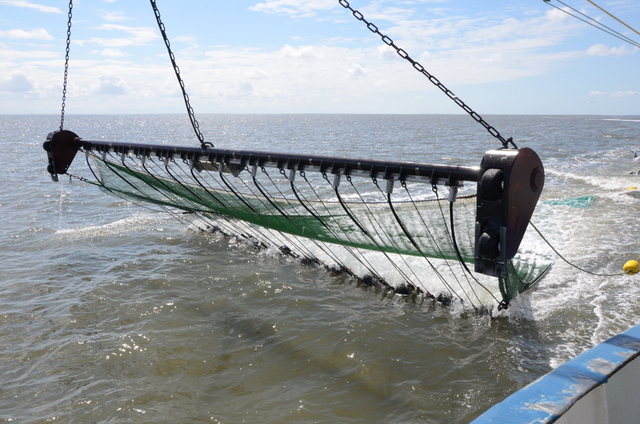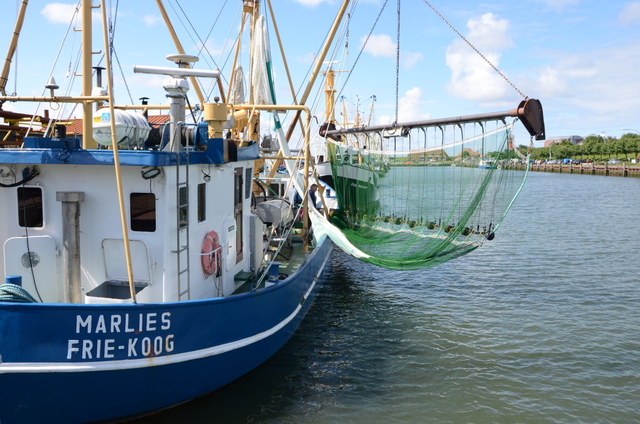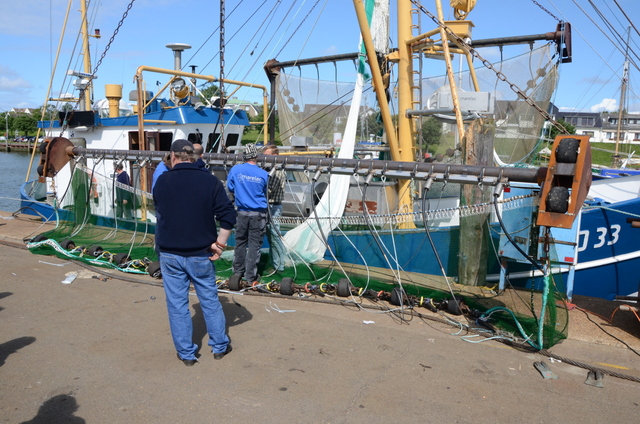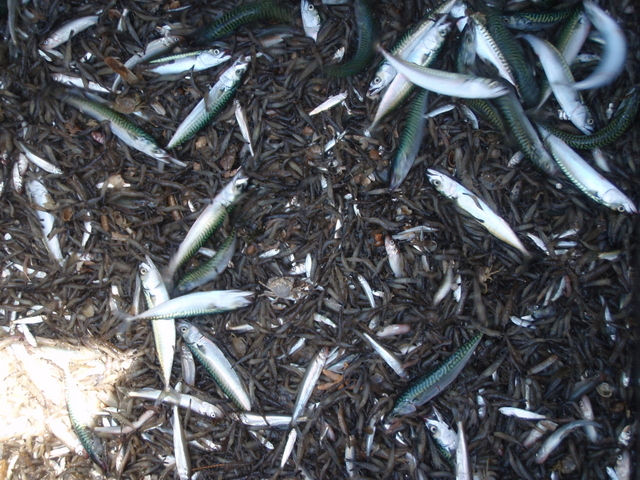Project
Pulse trawl for shrimp fishery

Ecological and economical investigations on the usability of an pulse-beamtrawl in the German brown shrimp fishery
Our project evaluates the usability of a pulse-beamtrawl in the brown shrimp fishery and its effect on bycatch, catch fo shrimp and the economy of this fishery.
Background and Objective
Main goal of our project is to improve the ecological and economical sustainability of the North Sea-brownshrimp fishery.
This fishery is a small and regional coastal fishery. Nevertheless, it is the most important German fishery - based on the economic revenues. Moreover, villages along the coast, benefit from the special flair of fishing vessels in the harbour. And last, but not least, brown shrimp are delicate - not only for tourists.
The bottom trawls, used in the North Sea-brown shrimp fishery, are held open horizontally by a solid metal beam - therefore this gear is called beam-trawl. Two skids ("shoes") are mounted at the side of the beam to help the gear sliding over the seabed. Behind the beam and the shoes, the net is attached. At the lower mouth of the net ("foot rope"), bobbins are used to keep the netting close to the bottom and to stimulate shrimp to jump off from the seabed in front of the net. A standard beamtrawl (8m width) has around 36 bobbins.
Unfortunately, the bobbins also stimulate other bottom living species, such as flatfish species. Usually, those unwanted animals are caught and discarded - a point of criticism. Another critical point is the bottom contact of the bobbins, which potentially harm the sea bottom and requires additional energy.
To omit the bobbins (or at least to reduce their number), other ways to stimulate the shrimp have to be found - ideally only the shrimp. One option is the usage of electrical fields. Our Belgian colleagues have conducted intensive research and developed a pulsed electrical field, optimized for shrimp. Based on these findings, a beamtrawl with 12 electrodes was developed. These electrodes produce a relative weak electrical field at a frequency of 4Hz (4 pulses per second). The consequences of these pulsed electrical fields on other marine organisms were investigated in Belgium. So far, no negative influence on such organisms was found.
Prior to the beginning of our project, first experiences and results about the usability of the pulse-beamtrawl were only available from a Belgian research vessel. The conditions of these sea trials do not fully match commercial fishery in Germany and the marine environment along the German coast. Additionally, a strong seasonal effects was expected. Therefore, it was decided by the fishery ministry of Schleswig-Holstein, representatives of the fishery and fishery scientists to conduct an experimental fishing to investigate the catch composition (taking into account the seasonal aspect), energy consumption and economic consequences when using a pulse-beamtrawl.
Additionally, we planned to evaluate further possibilities for an optimization of the pulse-beamtrawl.
ERROR: Content Element with uid "32839" and type "media" has no rendering definition!
Approach
In contrast to the Belgian experiments, it was not possible to remove all bobbins from the groundrope. The main reason was the different sea bottom characteristics in both areas, whereby it is more structured along the German coast. Therefore, some bobbins are needed slide the gear over the sea bottom - without increased risk for boat and crew. During our project, we have used a straight bobbin rope with only 11 bobbins - compared to usually 36 bobbins in an U-shaped groundrope. The reduced number of bobbins and the straight rolling direction influences positively the towing resistance and the impact on the sea bottom. Additionally, the reduction of bobbins results in larger distance between bobbins, which helps unwanted species to escape below the groundrope and between the bobbins.
Usually, shrimp vessel use two beam-trawls simultaneously: One net is towed on starbord-side, the other at portside. This allowed us to use the traditional beamtrawl and the pulse-beamtrawl at the same time in a direct catch comparison experiment. This is important to compare both gears under similar conditions, such as place, time, duration, speed, water depth, salinity, weather, currents etc.)
The experiments were conducted onboard a commercial trawler (SD33, "Marlies"; owner/skipper: Herbert Schoer). Hereby, an entire fishing year was sampled to resolve annual and diurnal effects on the catch of both gears.
Data and Methods
Measured biotic parameters:
- total catch, total shrimp catch, marketable shrimp catch (each per method);
- in bycatch: species composition, number per species, length distribution
Measured physical parameters under water (directly at the gear):
- temperature, depth, salinity, turbidity, light intensity
Additional parameters:
- geographic position, tow duration, trawl speed, time of the day, weather information (from weather database)
Our Research Questions
- Is it possibile to improve the selectivity of the beamtrawl and hence to reduce the unwanted bycatch?
- What are the consequences of the use of pulse-beamtrawl in German shrimp fishery regarding the catch of
- marketable shrimp
- undersized shrimp
- other organisms?
- Is the use of the pulse-beamtrawl feasible in German coastal waters?
- Can we reduce the amount of energy, needed to tow the gear over the bottom, when reducing the numer of bobbins?
- What are the economical consequences when using a shrimp-pulse-trawl regarding
- differences in catch of marketable shrimp
- energy savings
- initial and mantainance costs
Results
You can download the final report here (in German).
Summary of results:
- bycatch reduction possible
- high seasonal effect on the catch
- higher catches of marketable shrimps
- lower energy consumption
- initial costs around 75.000€, plus running costs
- economic success strongly depending on total revenue of catch and fuel prices (the higher, the higher the saving with pulse-beamtrawl).
- Further optimization of the shrimp-pulse-beamtrawl possible
The project was perceived with broad public interest. This resulted in a number of articles, tv- and radio broadcasts dealing with the pulse-beamtrawl (selection, in German):
- TV-broadcats „Die grosse Show der Naturwunder“ (ARD 24.07.2014)
- "Blaues Siegel für rosa Krabben" (Deutschlandradio Kultur 16.11.2013 )
- Fischerei - Mit Strom auf Krabbe und Seezunge (DRadio Wissen 16.09.2013)
- Krabbenfischer am Pranger (NDR4 Das Forum, 13.08.2013)
- Ungewollte Fische (arte Journal 09.04.2013)
- Pulsfischerei (3 Sat nano, 10.09.2012)
- Pulsbaumkurre in der Krabbenfischerei (Sat1 regional HH; 24.08.2012)
- Fischen, Forschen, Filetieren (ntv, 22.07.2012)
Thünen-Contact

Involved Thünen-Partners
Involved external Thünen-Partners
-
Marine Science Service (MSS)
(Dassendorf, Deutschland) - (Flanders Research) Institute for Agricultural and Fisheries Research, (ILVO)
(Oostende, Belgien)
Funding Body
-
Bundesland Schleswig-Holstein
(national, öffentlich) -
European Union (EU)
(international, öffentlich)
Duration
12.2011 - 3.2014
More Information
Project status:
finished









